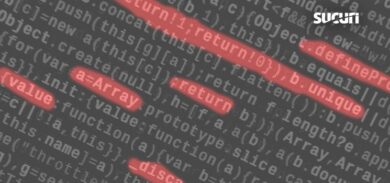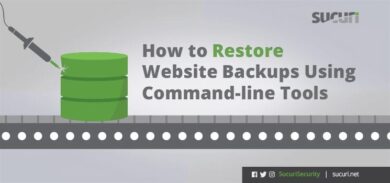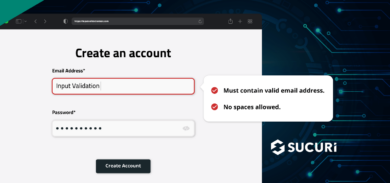SQL injection is one of the most common types of web hacking techniques used today. As data breaches continue to happen to some of the most high-profile corporations and brands, it’s become more important for web users to adapt to these increased breaches with changes in behavior like system generated passwords and 2FA.
In this post, we’ll be discussing SQL Injections in further detail, and why, as a website owner, you should care about this kind of attack.
What is SQL Injection?
SQL injection, or SQLi, is an attack in which an SQL query is inserted or “injected” via input data from a client to an application. It can be best described as an attacker interfering with the queries an application makes to its database. These queries primarily occur with PHP and ASP applications due to their prevalence of older functionality, while J2EE and ASP.NET applications are less likely to have easily exploited SQL injections.
This type of injection can allow an attacker to view data they’re not intended to retrieve such as customer records, intellectual property, or personal information. SQL injection can lead to an attacker doing any of the following:
- Locating administrator credentials
- Elevating privileges
- Compromising back-end infrastructure
- Spoofing
- Tampering
- Repudiation
- Disclosing sensitive information
- Denial-of-service (DoS) attacks.
How SQL Injection Attacks occur
This kind of attack is usually performed through a web page or application input. If a web application doesn’t validate values received from a web form, cookie, input parameter, etc., before passing them via SQL queries, it’s executed on a database server. If there’s no proper input validation, an attacker can manipulate the input so that the data is interpreted as code, rather than as data.
Here’s a recent encounter of an SQL injection, which was associated with a vulnerability found within the plugin known as Kaswara Modern WPBakery Page Builder.
Most Common SQLi Attacks
Ultimately, SQL Injection attacks can vary depending on the attacker’s skill and imagination. Here are a few examples of some of the most common ones found:
UNION Attacks
This type of SQL Injection is the most popular method performed by attackers. This injection technique allows an attack to retrieve data from different database tables by extending the results from the original query using the UNION keyword. For example:
SELECT a, b FROM table1 UNION SELECT c, d FROM table2
When an attacker can determine how many columns are returned from the original query and which are of an appropriate data type that hold results from the injected query, the attack is successful.
Blind SQL Injection
This attack is usually more sophisticated and more difficult to perform than other forms of injections. The results of the SQL query aren’t returned in the application’s responses. Neither are the details of any database errors. These blind vulnerabilities can be exploited to access unauthorized data. When generic error messages are received from the target, the attacker performs blind SQL injections. This method of retrieving database information is considered unique, compared to a regular SQL Injection.
Based on a response to true or false questions, an attacker is able to determine the answer based on the response received. They look at the time it takes to retrieve a server response and perform time-based attacks.
Boolean-Based SQL Injection
Boolean-Based SQL Injections rely on sending an SQL query to a database, and forces an application to return different results, depending on whether the result is true or false. If an application is vulnerable to SQL injections nothing will be returned, and then a query with a true condition (1=1) will be injected. If a false condition was returned but content on the page differs, an attacker can infer the SQL injection works.
This injection technique is frequently used to test how vulnerable an application is.
Error-Based SQL Injection
With an Error-Based SQL Injection, attackers will exploit database errors from a web page or application that are triggered by unsanitized inputs. This technique utilizes error messages to return full query results, and reveals classified information from a database. The method can be used to identify if a site or web application is vulnerable, and to retrieve additional hidden data to restructure malicious queries.
Time-Based SQL Injection
During a normal SQL Injection, bad actors can simply examine the database as information (like the version and structure), returned over text. When bad actors are unable to retrieve information from a database however, they could deploy time-based SQL injections to achieve successful results. This functions by using operations that take a long time to complete, often many seconds.
These injections are normally used when determining if vulnerabilities exist on a web application or website, as well as in conjunction with Boolean-based techniques during Blind SQL Injections.
How SQL Injections can be detected
In order to identify an SQL Injection you’ll first need to pinpoint where the vulnerability is located by launching a scan, or running an automated SQL injection attack tool. Tools such as Havij, SQLmap, or jSQL should be able to help identify the vulnerable code. Once the vulnerabilities are identified, you’ll then need to remove the malicious injections or have a team clean it up for you.
After the code is removed, you’ll want to make sure all databases, applications, third-party systems, or any other out-of-date components are patched & updated regularly. You’ll also need to update all passwords once the vulnerabilities are patched, utilizing strong characters of course. In addition, setting up a tool that regularly monitors any rogue SQL statements using behavioral analysis and/or machine learning can also help detect indicators of compromise (IoC) in the future.
How SQL Injections can be prevented
These attacks can be remediated by using proper input validation and prepared statements with parameterized queries – instead of string concatenation within the query. In order for parameterized queries to be effective in preventing SQL injections, the string used in the query needs to be a hard-coded constant and cannot contain any variable data from any origin.
Another preventative measure is using stored procedures, which make it more complicated for attackers to execute malicious SQL. This is because stored procedures are unable to be dynamically inserted within queries.
It’s also important to never trust user-submitted data. Performing an allowlist validation to test user input against an existing set of known, approved, and defined input is beneficial. If data is received that doesn’t meet the assigned criteria, it’s rejected. This prevents malicious injections from occurring on the application or website.
Additionally, it’s important to set privileges to an absolute minimum for all accounts. This principle ensures website security threats are mitigated. You should only grant privileges when it’s necessary, and not assign administrator privileges to application accounts.
SQL injection flaws crop up when database queries include user-supplied input. Because of this, dynamic queries should be avoided if possible. The overall priority should be preventing user-supplied input that contains malicious SQL from affecting the logic of the executed query.
The final thing to consider when protecting against SQL injections is implementing a Web Application Firewall. Firewalls filter out dangerous requests, including those that are SQL injection attempts.
In Conclusion
There are definitely a lot of factors to consider when it comes to these types of attacks, and it can become extremely overwhelming to a business when this occurs. Since remaining hidden is a priority for most attackers, finding out whether you’re a victim of an attack can be tricky. With the right tools in your security arsenal, you can find out, overcome the attack, and stop it from occurring again.
If you think you are currently being impacted by an infection or attack, don’t hesitate to reach out to our team to investigate.










